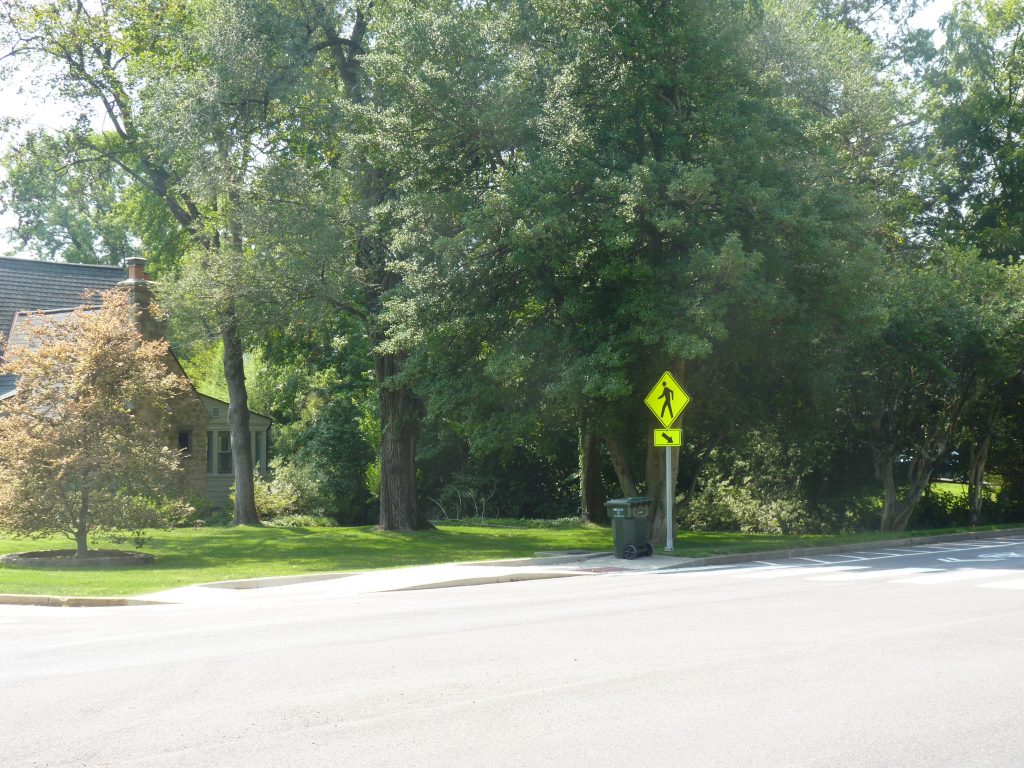Correction: The original caption for the photo of E. Jefferson Street’s cul-de-sac said that the pink tree pictured in it could be a candidate for removal due to stormwater upgrades. That is incorrect. The language of the caption has been updated to reflect this information.

To make the necessary stormwater improvements throughout the City of Falls Church, some trees have to be removed. It’s not a thrilling topic of conversation for a place that’s held the title of a “Tree City USA” for 40-plus years, but it’s also one that won’t result in the permanent loss of tree canopy that some fear.
The pages of the News-Press’ “Letters to the Editor” section was where those concerns played out. One letter, published on July 1, criticized home builders for removing trees during one of their projects. A follow up letter the next week redirected attention toward the City’s planned stormwater improvements for the reason that tree root systems were going to be destroyed and why they needed to be removed.
Eyes will naturally turn toward the City officials who approve of these developments and the subsequent denuding that takes place. However, City Arborist Charles Prince said that these removals aren’t typically a contentious process. In his work, most people are open to having a tree removed for free, and get a new one planted that can be more modestly sized. He also holds the power to overrule any tree replacement suggested by the developer to make sure it’s in line with what works for Falls Church.
“I can veto any tree, so if it’s an invasive species that will proliferate and spread, kind of out of control, I can deny that tree,” Charles Prince, the City’s arborist, said. “Outside of that, developers are afforded a bonus when they plant native trees…and generally, that’s what we always see the majority of the time. We see native trees going in on properties.”
The new trees may not be as mature as the ones being removed, as you might expect, meaning that there is a chance it could affect home values. According to HGTV.com, a mature tree can boost the value of a home from seven to 19 percent. That’s not including the energy savings shading can provide.
But the City also has a more aggressive timeline in maintaining its canopy than the state of Virginia does when a replacement is put in place. The preservation and/or planting on the lot should provide 20 percent of the lot to be covered within 10 years. The state’s requirement is to achieve 20 percent of canopy coverage within 20 years.
How open people are to having their trees removed will be tested once the City’s “Big Six” of stormwater projects gets underway. Totalling just over $8 million, the improvements are still in the planning phase, but the scope of addressing the “grey” pipe infrastructure that was first installed nearly 100 years ago will be an expansive process. The stated goal of the improvements are so the City can better withstand severe weather events, namely deluges of summer rain, that are said to be a result of climate change.

The pipes that collect stormwater typically run parallel or adjacent to the main streams within the City — being Tripps Run and Four Mile Run and their many, sometimes buried, tributaries. They also often cross into privately owned land, requiring either land donations or negotiations by the residents in order to carry out the stormwater upgrades, according to Public Works Director Zak Bradley.
There are a few proposed improvements that rely heavily on accessing private property.
An existing stormwater system runs through a home on the corner of Poplar Drive and Spring Street. The proposed route appears to shift the route right underneath the tree line separating the home from its neighbor, and could potentially see some removals if that project goes through as planned.
The Harrison branch of Four Mile Run cuts through multiple private properties as it passes through the cul-de-sac at the end of E. Jefferson Street and underneath E. Columbia Street until it forks, heading toward both Noland Street and Midvale Street. The City’s current stormwater system runs parallel to that branch most of the way, meaning that at least six separate homeowners will be affected by the upgrades.
Connecting a new stormwater pipe to an existing one at the corner of Brook and Berry Street would then follow the road to Hillwood Avenue before it veers into two homes with significant foliage by the corner of Linden Lane.
All properties affected by the stormwater improvements will be looked over by the Stormwater Management Review team, and those proceedings will be advertised to all homeowners and neighbors who are within a 150-foot radius of the project, according to Bradley.
A more robust stormwater system means that it could compete with soil trees need to nourish themselves. It’s inevitable some trees will be removed as a part of these upgrades, though it’s not the first route City officials will go to.
For all projects that take place in the City, including stormwater projects, developers hire an independent arborist and submit a grading plan. The City’s arborist reviews and comments on it, and if all requirements are met, approves the grading plan. One of the suggestions Prince can make is that, if a lot is big enough, the City can find a way to move the house in order to make room for the improvements. That could wind up preserving a tree in some cases.
In others, the City arborist will collaborate with the hired arborist to determine if a tree will be safe. If it is, again, Prince has veto power. If the tree will not be safe — either health-wise, or will create a hazard for the homeowner and its neighbors in danger of falling — then it has to be removed.
“We’re definitely not asking for removal of any trees unless there is a safety concern,” Bradley said.









